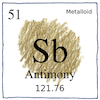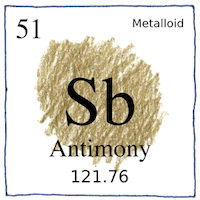Egypt
elements

|
Antimony
Antimony, the brittle metalloid, confused with lead, was available as stibnite (the sulfide of antimony) to predynastic beauties of the upper Nile to paint the contours of the eyes. Pliny the Elder proscribed it as a disinfectant. Pedanius Dioscorides suggested roasting it in a current of hot air. In India, people applied it to the eyes of children after birth to prevent the evil eye.
Atomic number 51
Vannoccio Biringuccio, was the first to describe, in 1540, metallic antimony, that is, distinct from the sulfide of antimony, as “very white and almost more shining than silver” and “much more brittle than glass.” He said that the alchemists favored “the kind with long thin fibers like a bundle of bristles.” Clearly, the discovery of metallic antimony predates Biringuccio since his alchemist friends knew of it.
The lost art
The lost art of rendering antimony malleable is only fantasy. Like the philosopher’s stone it never existed although smart people have wasted effort and lost time.



Biringuccio’s book De la pirotechnia might have been the first technical and scientific work.
See also in The book of science:
Readings in wikipedia:
Other readings: